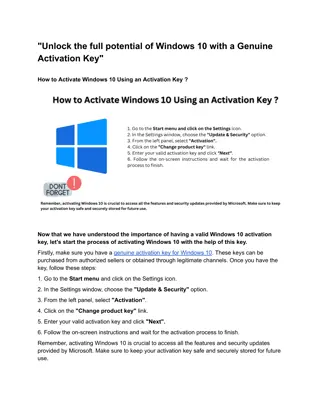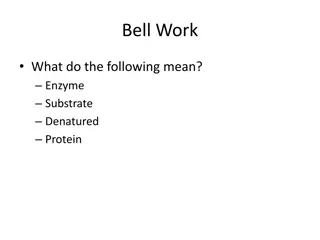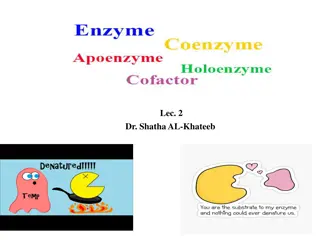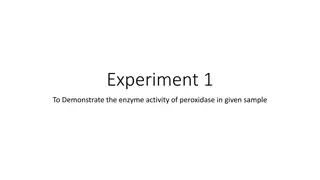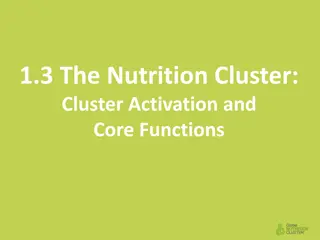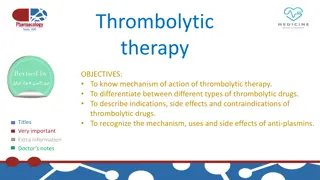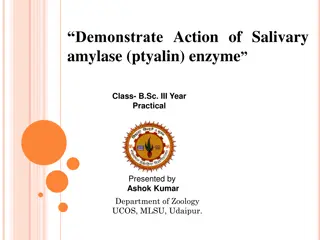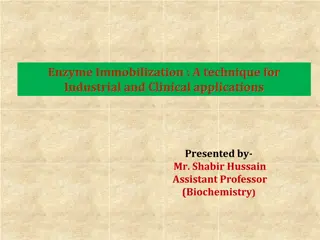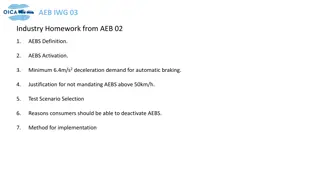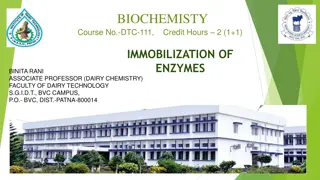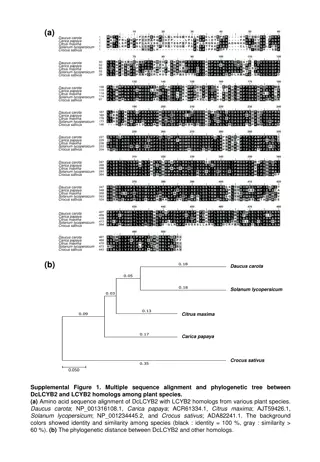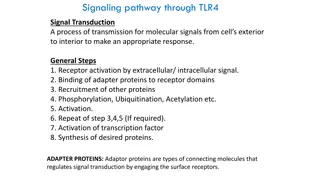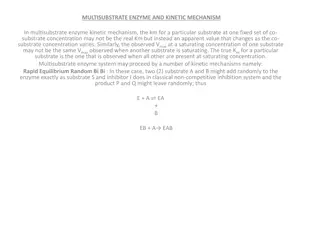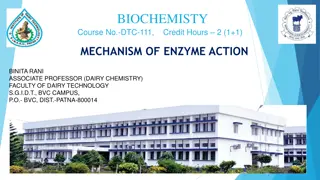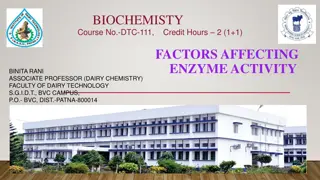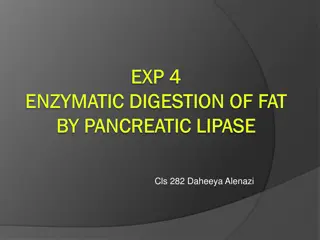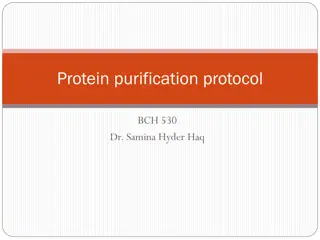Prevalence of KIT D816V Mutation in Patients with Systemic Mast Cell Activation
This study presents findings from the PROSPECTOR clinical trial on the prevalence of the KIT D816V mutation in the peripheral blood of patients with systemic mast cell activation. The study involves multiple centers globally and sheds light on the significance of this mutation in systemic mastocytos
5 views • 14 slides
Enzymes are Proteins that act as Biological Catalyst
Enzymes, as proteins acting as biological catalysts, accelerate chemical reactions without being consumed. They have active sites where substrates bind, and their specificity can be lock-and-key or induced fit. Enzymes are named based on their function or the substrates they interact with. Enzyme sp
5 views • 20 slides
Understanding the Role of Phosphatase Enzymes in Metabolic Reactions
Phosphatase enzymes play a crucial role in various metabolic processes by releasing phosphate groups, increasing their availability for energy synthesis and cell structure formation. Acid phosphatases, with an optimum pH below 7.0, can be extracted from plant tissues like germinating mung beans. A p
7 views • 34 slides
Understanding Enzyme Function Through Induced Fit Model
The learning content discusses enzymes as biological catalysts that increase reaction rates by lowering activation energy. It explores how enzyme activity efficiency is influenced by factors such as temperature, pH, and substrate concentration. The Induced Fit Model is analyzed to explain how enzyme
5 views • 12 slides
Unlock the full potential of Windows 10 with a best Genuine Activation Key
Unlocking the full potential of Windows 10 requires a genuine activation key that provides access to all the features and functionalities of the operating system. A genuine activation key not only ensures compliance with Microsoft's licensing terms but also guarantees security updates, technical sup
3 views • 8 slides
Investigating the Impact of Pineapple Enzyme Bromelain on Gelatin and Pasteurization Process
Explore the effects of pineapple enzyme bromelain on gelatin and how pasteurization can alter its effectiveness in this lab experiment. Discover the different outcomes when using fresh versus canned pineapple and formulate hypotheses to guide the investigation. Follow step-by-step procedures to test
0 views • 15 slides
Factors Affecting Enzyme Activity and Catalysis
Enzyme activity is influenced by various factors such as enzyme concentration, temperature, pH, substrate concentration, inhibitors, activators, and physical agents. The rate of enzyme-catalyzed reactions is directly proportional to enzyme concentration, and temperature plays a significant role with
0 views • 23 slides
Understanding Enzyme Function: The Key Steps and Importance of Cofactors
Enzymes play a crucial role in catalyzing biochemical reactions by forming enzyme-substrate complexes and facilitating changes in substrate molecules to product molecules. The process involves four steps: proximity of enzyme and substrate, binding at the active site, catalysis leading to substrate a
0 views • 39 slides
Understanding Peroxidase Enzyme Activity in Biological Samples
Demonstrating the enzyme activity of peroxidase, an enzyme that plays a crucial role in breaking down hydrogen peroxide in various organisms. Learn about the differences between peroxidase and catalase, the calculation of enzyme activity, and the significance of extinction coefficient in enzyme assa
0 views • 8 slides
Understanding the Nutrition Cluster Activation and Core Functions
Exploring Level 3 emergencies, the process of cluster activation and deactivation, and the core functions of the Nutrition Cluster at the country level. Learn about the criteria for cluster activation, gaps in response, and the strategic approach to humanitarian system-wide emergency activation. Dis
3 views • 21 slides
Exploring Enzyme Kinetics for Understanding Chemical Reactions
Enzyme kinetics is a vital discipline focusing on the rate of enzyme-catalyzed reactions and how they respond to varying conditions. Reactions are classified based on reactant concentration influences. Zero, first, second, and third order reactions are distinguished, with examples like first-order r
0 views • 31 slides
Understanding Thrombolytic Therapy and Plasminogen Activation
Thrombolytic therapy involves the use of drugs to dissolve blood clots, with plasminogen activation being a key mechanism. Different types of thrombolytic drugs like fibrin-specific and non-fibrin-specific agents are available, each with varying effects on clot dissolution and systemic plasminogen a
1 views • 13 slides
Demonstration of Salivary Amylase Enzyme Action in B.Sc. Practical
Salivary amylase, an enzyme found in saliva, partially hydrolyzes starch into maltose. This practical involves observing the action of salivary amylase on starch, demonstrating how starch is broken down into glucose and maltose. The procedure includes preparing solutions, collecting saliva, mixing w
0 views • 5 slides
Enzyme Immobilization: Techniques and Applications in Industry and Healthcare
Enzyme immobilization involves confining enzymes on inert supports for stability and reuse, enhancing efficiency and cost-effectiveness. Historical events and examples illustrate various methods and applications. Chemical modifications, such as PEG addition, have shown increased enzyme activity. The
0 views • 34 slides
Advanced Emergency Braking System (AEBS) Definition and Activation Guidelines
The provided content outlines the definition and activation requirements of the Advanced Emergency Braking System (AEBS). It covers the phases involved, including Collision Warning and Emergency Braking, as well as the speed limitations for activation. The system aims to automatically detect potenti
0 views • 12 slides
Factors Affecting Enzyme Activity and Kinetics Experiments
Explore the factors influencing enzyme activity, such as substrate and enzyme concentration, temperature, pH, and inhibitors. Learn how to simulate enzyme kinetics using equipment like popping beads and stopwatches. Analyze results to understand the impact of substrate concentration on reaction rate
0 views • 22 slides
Understanding Enzyme Activity and Optimal Conditions
This interactive content provides a detailed exploration of enzyme activity through data interpretation and graph analysis. Questions range from identifying the impact of enzymes on specific molecules to determining optimal conditions for various enzyme functions such as pH and temperature. Users de
0 views • 16 slides
Immobilization of Enzymes in Biochemistry
Enzyme immobilization involves confining enzyme molecules to a distinct phase from substrates and products, attaching them to solid matrices for enhanced specificity and reduced inhibition. Inert polymers or inorganic materials are used as carrier matrices with methods like physical adsorption onto
0 views • 24 slides
Zymogens and Ribozymes: An Overview of Inactive Enzyme Precursors
Zymogens, such as trypsinogen and pepsinogen, are inactive enzyme precursors that are activated through specific cleavage in various biological environments. Understanding the activation process of zymogens sheds light on how enzymes are regulated and function in the body.
0 views • 17 slides
Understanding Enzyme Inhibition in Biochemistry
Enzyme inhibition plays a crucial role in pharmacology and biochemistry by regulating enzymatic reactions. Inhibitors can be reversible or irreversible, affecting enzyme activity differently. Competitive, uncompetitive, and noncompetitive inhibition types are explained along with examples like diiso
0 views • 20 slides
RRM Enhancement for NR and MR-DC: PUCCH SCell Activation Requirements
In the electronic meeting of 3GPP TSG-RAN-WG4, the discussions focused on enhancing RRM for NR and MR-DC, specifically addressing PUCCH SCell activation/deactivation requirements. Points were made regarding the ending points of PUCCH SCell activation for both valid and invalid TA cases, beam informa
0 views • 15 slides
Plant Enzyme Activities and Phylogenetic Analysis
The content discusses the alignment of various plant enzyme amino acid sequences, including DcLCYB1, DcLCYB2, and DcLCYE, among different inbred lines. It also explores the construction of DcLCYs for enzyme activities using an E. coli complementation assay. The phylogenetic relationship between DcLC
0 views • 5 slides
Demonstration of Salivary Enzyme Amylase Action in B.Sc. Practical
Salivary enzyme amylase, also known as ptyalin, plays a crucial role in breaking down starch and glycogen into maltose. This practical session in the Zoology department explores the action of salivary enzyme amylase at a temperature of 37°C and pH of 6.6. By conducting experiments with starch, iodi
0 views • 8 slides
Shadow Opinion on Activation Purposes Proposal: Insights and Recommendations
The shadow opinion addresses definitions, interpretations, and the proposed classification criteria for activation purposes in balancing energy bids. It discusses the clarity of terminology, necessity of terms, and the need for a comprehensive list of possible purposes. Additionally, it raises conce
0 views • 7 slides
Signaling Pathway Through TLR4: A Molecular Signal Transduction Process
Signaling through Toll-like Receptor 4 (TLR4) involves a series of steps starting from receptor activation to transcription factor activation, leading to the synthesis of desired proteins. The pathway can occur through MyD88-dependent or TRIF-dependent pathways, resulting in different downstream eff
0 views • 5 slides
Emergency Operations Activation Levels in Healthcare
Develop a plain language Emergency Operations Plan activation level matrix to enhance the common operating picture among healthcare and emergency management agencies. Hospitals use varying means to describe activation levels, and implementing plain language descriptors will facilitate mutual aid and
1 views • 13 slides
DL Synchronization and TCI State Activation Discussion
Discussing DL synchronization including TCI state activation with scenarios for beam indication timing, unified TCI framework, and reducing handover delay for Rel-18 LTM. Different procedures for DL synchronization and TCI state activation are explored, highlighting the importance of understanding a
0 views • 7 slides
Understanding Activation Rate in Link 2017: Insights and Strategies
Activation rate in the context of Link 2017 refers to the process where newly elected members attend their first Order of the Arrow (OA) event, indicating their activation. The journey of a new member involves awareness, election, call-out, induction, activation, engagement, and renewal. The data fr
0 views • 17 slides
Understanding Enzyme Assays in Biotechnology
Exploring enzyme assays in biotechnology, covering topics such as ELISA, protein assays, enzyme activity measurement techniques, specific activity, terminology related to enzyme assays, and different types of experiments conducted by biochemists to study enzyme-catalyzed reactions. The content delve
0 views • 53 slides
RWA Housing Society Activation BTL Activation
RWA Housing Society Activation is a targeted BTL (Below The Line) marketing strategy by Fulcrum Resources that engages directly with residents in housing societies. This activation aims to create brand awareness and generate leads by organizing event
3 views • 5 slides
Cyanide's Impact on Respiration Through Enzyme Inhibition
Cyanide, a noncompetitive inhibitor of the enzyme cytochrome c oxidase, disrupts electron transport in respiration by binding to the iron cofactor and blocking electron transfer to oxygen. This lethal effect was utilized in gas chambers during WWII, underscoring the crucial role of enzyme function i
0 views • 7 slides
Understanding Multisubstrate Enzyme Kinetic Mechanisms
In multisubstrate enzyme kinetic mechanisms, the apparent Km and Vmax values change with varying substrate concentrations. Different kinetic mechanisms like rapid equilibrium Bi Bi and ordered Bi Bi reactions can occur. The ping-pong Bi Bi reaction involves oscillation between enzyme forms. Various
0 views • 11 slides
Understanding Enzyme Action: Mechanisms and Models
Enzymes play a crucial role in biochemical reactions by recognizing specific substrates and catalyzing reactions at remarkable speeds without being consumed. This article delves into the mechanisms of enzyme action, including the lock-and-key and induced-fit models, highlighting how enzymes lower ac
0 views • 17 slides
Activation and Smart Safety Nets in the Western Balkans: Addressing Employment Challenges
Activation strategies aim to transition individuals from dependence on social benefits to active participation in the labor market. The Western Balkans face high unemployment rates, highlighting the need for effective activation policies. By emphasizing employability and reintegration, activation in
0 views • 40 slides
Factors Affecting Polyphenol Oxidase Activity in Enzyme Reaction
Polyphenol oxidase (PPO) is a copper-containing enzyme with an optimal pH of 6.7 that catalyzes the oxidation of phenols, leading to color changes like browning in fruits and potatoes. This experiment aims to demonstrate PPO activity, its chemical nature, substrate specificity, and the effects of te
0 views • 18 slides
Understanding Factors Affecting Enzyme Activity in Biochemistry
Enzyme assays measure substrate conversion to product under varying conditions like cofactors, pH, and temperature. Enzyme velocity represents the rate of a catalyzed reaction, typically reported as V0. Enzyme activity is expressed as mol of substrate transformed per minute, with enzyme unit and kat
0 views • 18 slides
Enzymatic Digestion of Fat by Pancreatic Lipase
The experiment focuses on studying the enzymatic digestion of fat by pancreatic lipase. It covers the structure of triglycerides, the role of lipase enzyme in hydrolyzing triglycerides to release fatty acids, and the general hydrolysis process. The aim is to investigate the effects of lipase enzyme
0 views • 9 slides
Understanding LacZ - Galactosidase Enzyme: Structure, Function, and Applications
LacZ - galactosidase enzyme, encoded by the lacZ gene in the lac operon, plays a crucial role in cleaving lactose, transgalactosylation, and regulating gene expression. Its application in labs using X-gal as a substrate allows for easy detection of active enzyme through color changes. This versatile
0 views • 13 slides
Protein Purification Protocol: Practical Training in Biochemistry Techniques
This protein purification protocol course, led by Dr. Samina Hyder Haq, focuses on practical training in various biochemistry techniques. The course covers organizing experimental protocols, protein isolation strategies, sequential enzyme purification, enzyme kinetics, and writing scientific reports
0 views • 25 slides
Understanding Enzyme Regulation and Factors Affecting Enzyme Activity
Organisms carefully control enzyme production and activation as per varying needs and conditions within cells. Enzyme activity is influenced by factors such as pH, temperature, regulatory molecules, cofactors, compartmentalization, covalent modification, and feedback inhibition. Enzymes can be regul
0 views • 20 slides




